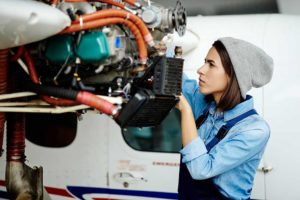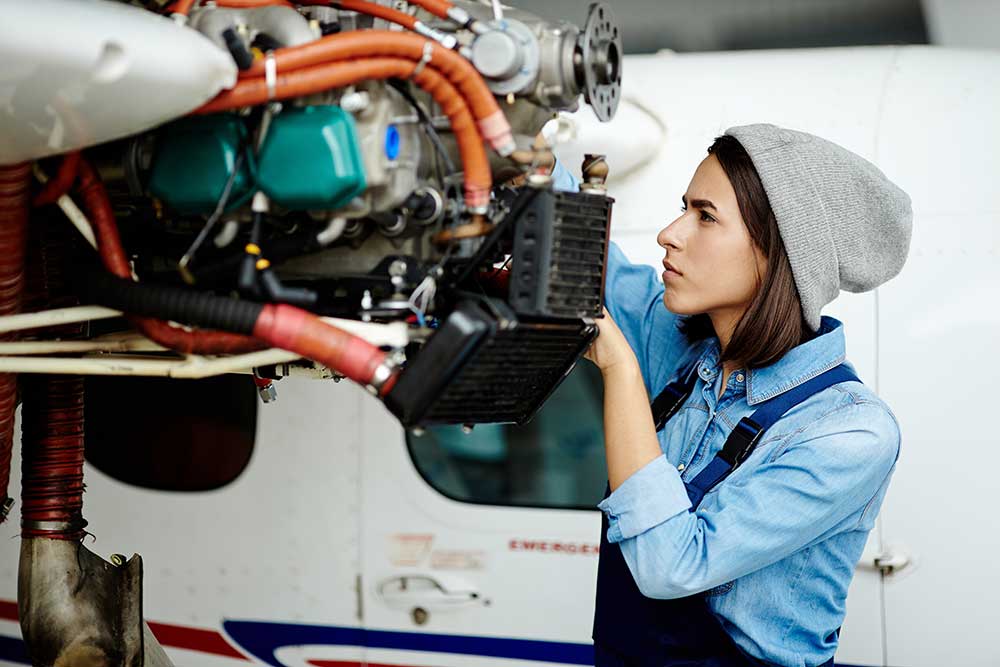Disclaimer: The information on our website is provided for general information purposes only. We make no representations or warranties of any kind, express or implied, about the completeness, accuracy, reliability, suitability or availability with respect to the website or the information contained on our website for any purpose. Any reliance on such information is therefore strictly at your own risk and we are not liable for any damages or losses arising out of or resulting from your reliance on any information contained on our website.
An aircraft maintenance technician ensures aircrafts are in optimal condition. They do this by examining parts, identifying problems, and performing scheduled maintenance and repairs. In addition, some of their daily work is dictated by Federal Aviation Administration (FAA) regulations and guidelines. Watch a video to learn what an aircraft maintenance technician does:
How to Become an Aircraft Maintenance Technician
Step 1: Attend a Technical School
In order to become an aircraft maintenance technician most techs attend a Part 147 FAA-approved Aviation Maintenance Technician School. During this program, a technician gains the skills required by the FAA. Though some people decide to enroll in a program, others enter this career field directly after being trained in this career field through their military service.
Step 2: Take FAA Exams
Though not required, you are also eligible to sit for several FAA (Federal Aviation Administration) exams to become certified. These exams increase your employment opportunities and may give you some leverage when applying for a position and during salary negotiations.
Job Description of an Aircraft Maintenance and Technician

Aircraft maintenance technicians use diagnostic equipment and gauges to test aircraft parts and records of all work done. Thus, they must also inspect machinery to ensure it functions correctly. In addition, aircraft maintenance technicians generally work on general aircrafts, piston-driven airplanes, helicopters or jets.
Some technicians choose to specialize in a particular area like hydraulics, engines, or other interest areas. For awareness, techs must also be physically fit, be able to balance, reach, and lift heavy objects. Also, they must handle dangerous chemicals and operate large power tools. Often, these technicians work on ladders or scaffolds and endure loud noise and vibrations. The risk of injury and illness is high for this occupation compared to other types of jobs.
Aircraft maintenance technicians can be found working for private companies, airports, or the federal government. They work in hangers, repair stations, or airfields unless employed by the military, in which case they work may work at military installations or remote sites. A aircraft maintenance technician usually works full-time in 8 hour shifts. Overtime and weekends are required at times.
Free Teacher and Student Resources
The Massachusetts Institute of Technology (MIT) offers a free Introduction to Aerodynamics course on EdX.org. However, there is an option to pay a small fee receive a verified certificate upon completion of the course. By taking this course, you’ll learn:
- Basics of aerodynamics.
- Fundamentals of potential flows from subsonic to supersonic speeds.
- Viscous flows including laminar and turbulent boundary layers.
- Aerodynamic models of airfoils and wings.
Avionics Technician Career Video Transcript
Avionics technicians keep airplanes in the sky. They repair and maintain components used to keep flights running smoothly. Whether they test the aircraft’s navigation and weather radar to keep it safely on-route, or fine-tune radio communications to keep pilots in touch with the experts on the ground, avionics technicians take care of the systems that we depend on for long-distance travel. Dealing with noise, vibration, and heavy equipment is a common part of every shift.
These technicians must analyze complex electronic problems and develop safe, workable solutions. Often, the work is done on a deadline to turn around aircraft due to get back up in the air in a matter of hours. This is one of the highest paid technical professions and it’s easy to see why. The work is very complex and vitally important.
Avionics technicians work for airlines, manufacturers, and at repair facilities. Training is available at trade schools certified by the Federal Aviation Administration but an engineering background is helpful. Certification is not required if you work under a certified technician, but higher pay and better opportunities may be available if you earn a certificate, which requires written, oral, and competency tests. This is a job where safety can never take a back seat to schedule.
Article Citations
Bureau of Labor Statistics, U.S. Department of Labor, Occupational Outlook Handbook, Aircraft and Avionics Equipment Mechanics and Technicians.
National Center for O*NET Development. 49-3011.00. O*NET OnLine.

